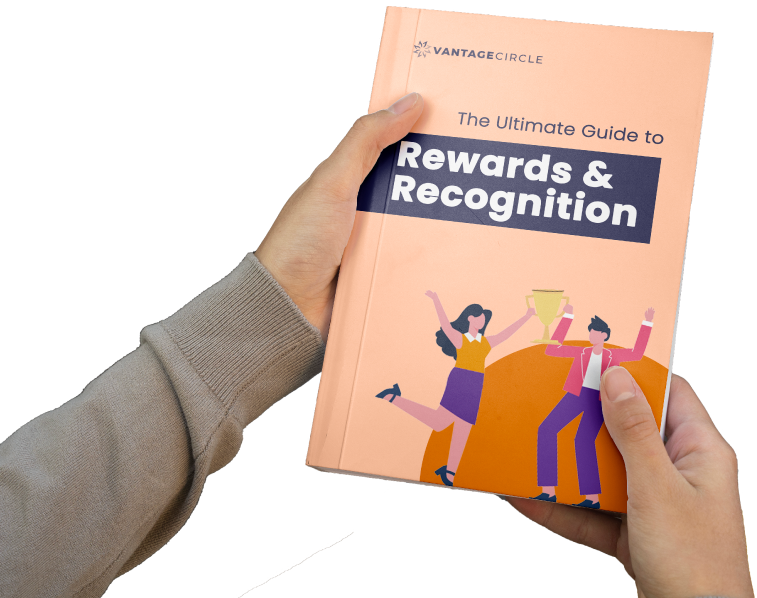25+ Creative Ways to Reward Employees Without Spending a Dime

A Global Employee Recognition and Wellness Platform
A few years ago, a manager handed out cash bonuses to recognize top performers. Everyone smiled, thanked him—and a week later, it was business as usual. But when he introduced flexible Fridays and celebrated wins in team meetings, something changed. People stayed late without being asked, collaborated more, and started showing up with renewed energy.
Turns out, the numbers back this up. 79% of employees would prefer new or additional benefits over a raise(Glassdoor). And 58% say they’d stay at a lower-paying job if they felt more appreciated.
The truth is, money gets attention—but meaning holds it. In a post-pandemic world where burnout is high and budgets are tight, non-monetary rewards are proving not only more sustainable but also more powerful. From recognition and autonomy to growth and purpose, today’s workforce craves more than a paycheck.
Because at the end of the day, people remember how you made them feel—not what you paid them.
The Psychology of Non-Monetary Recognition
Intrinsic Motivation and Emotional Resonance
If you’ve ever read Drive by Daniel Pink, you know he breaks motivation down into three powerful drivers: autonomy, mastery, and purpose. And I’ve found these really explain why non-monetary rewards can be more meaningful than money.
- Autonomy is about having control over how we do our work. When we’re trusted to manage our time or choose our own projects, we feel more invested.
- Mastery is our built-in drive to get better at things that matter. Recognition, feedback, or learning opportunities feed that need.
- Purpose is knowing our work serves something bigger than ourselves. Feeling connected to a mission—or just knowing your effort made a difference can be incredibly motivating.
The truth is, money might get people in the door, but it doesn’t keep them excited about the work. Non-monetary rewards, like being thanked in front of the team or offered a chance to lead something new, stick with us much longer.
There’s even research to back it up. One study showed that employees who received a physical token of appreciation felt 23% more satisfied in their jobs six months later, compared to those who got a cash bonus.
Why? Because of something called “trophy value.”
That small token, whether it’s a handwritten note, a team award, or even a silly desk trophy, becomes a personal reminder of a moment we’re proud of. You don’t frame a $50 gift card on your wall, but you might display a thank-you letter from your manager.
And that’s the kind of thing that keeps us going.
Social Reinforcement and Cultural Alignment
Recognition isn’t just personal—it’s also social. When someone’s work is celebrated publicly, it reinforces what the company truly values. It helps people feel like they belong and shows others what behaviors are appreciated.
I've seen how something as simple as a “Great job!” in a team meeting or a shoutout in Slack can make someone’s whole day and inspire others to step up. Recognition has a ripple effect.
There are tools like Vantage Circle (VC) that help make this a habit. It lets teammates send quick kudos, award badges, or highlight wins in real time. It makes appreciation part of the everyday workflow, not just a once-a-year performance review.
When recognition is baked into the culture, it’s easier to keep people motivated, connected, and aligned—and you don’t have to spend a dime.
25+ Proven Ideas to Reward Without Money
Free, meaningful, unforgettable: Employee rewards that go beyond money.
1. Formal Awards and Symbolic Tokens
Tangible recognition serves as a lasting reminder of achievement; it not only validates the effort in the moment but reinforces a sense of pride and accomplishment over time.
Certificate of Excellence – Design and share a personalized award (even virtually).
Use case: Great for monthly or quarterly recognition cycles.
"Team MVP" Badge – Let team members nominate and vote for their pick.
Use case: Ideal for celebrating post-project wins.
Trophy Value Tokens – Desk items, digital badges, or plaques act as lasting reminders.
Use case: Works well for remote and hybrid teams.
“We often underestimate how meaningful symbolic recognition can be—employees remember how they felt far longer than what they were paid.”
— Priya Mehta, Head of People Experience, Growbly
2. Peer-to-Peer Recognition Platforms
I’ve found that building a culture of continuous appreciation starts with using simple, consistent tools that make recognition a natural part of our daily workflow.
Vantage Circle – Let coworkers send points, emojis, and shoutouts.
Use case: Perfect for distributed or async teams.
Slack Kudos Channel – Create a dedicated space for weekly gratitude.
Use case: Easy to scale and democratizes recognition.
“Peer-driven recognition creates an inclusive feedback loop—it’s one of the most powerful engagement tools we use.”
— Jared Kim, Global HR Director, MindMesh
3. Verbal and Written Appreciation
Sometimes, a few thoughtful words can resonate more than any formal reward.
Handwritten Thank You Note – Simple, memorable, and heartfelt.
Use case: Works especially well with introverted team members.
Public Praise in Team Meetings – Celebrate wins in front of peers.
Use case: Use after a big deliverable or cross-team success.
Manager 1:1 Recognition – Make it part of regular check-ins.
Use case: Keeps morale high without needing a formal moment.
4. Flexibility as a Reward
Offering time and flexibility shows trust and can be more impactful than traditional rewards.
Meeting-Free Day – Gift a no-call day for deep focus or recovery.
Use case: Great after a crunch period or product launch.
Work From Anywhere Pass – Let them pick their favorite café or spot.
Use case: Especially appreciated by remote teams.
Late Start or Early Wrap-Up Day – Give them back control over their time.
Use case: Helps avoid burnout while still meeting goals.
5. Skill-Building Opportunities
Give them a path to grow professionally.
Skill Swap Sessions – Let team members teach each other.
Use case: Great for smaller teams with varied expertise.
Side Project Access – Assign an internal project they’re passionate about.
Use case: Motivating for high-performers or creatives.
“Development is recognition—giving someone the chance to grow shows trust.”
— Lina Hoffman, Talent Strategy Lead, PeopleCraft
6. Mentorship and Job Enrichment
Stretch roles and guidance fuel long-term motivation.
Shadow a Leader – Offer a day with a senior leader or different team.
Use case: Ideal for high-potential or curious team members.
Reverse Mentoring – Empower junior employees to coach leaders in new tech or trends.
Use case: Promotes cross-generational learning and recognition.
Stretch Assignments – Let them try a leadership or strategy role short-term.
Use case: Builds confidence and visibility.
7. Autonomy and Ownership
Trust is a reward in itself.
Lead Meeting - Let Them Lead a Meeting or Initiative
Use case: Builds leadership skills and showcases talent.
Project Pick Pass – Let them choose their next assignment.
Use case: Keeps people engaged and aligned with their interests.
"Create the Process" Challenge – Invite them to improve how work is done.
Use case: Encourages innovation and gives employees a voice.
8. Volunteer Time Off (VTO)
Give back while recognizing purpose.
Half-Day for Volunteering – Let them support a cause they care about.
Use case: Works great for mission-driven companies.
Team Volunteer Challenge – Offer praise and visibility for group impact.
Use case: Strengthens team bonds and employer branding.
9. Wellness Initiatives
Show you care about their whole self.
Midday Mindfulness Break – Block off time for yoga, walking, or meditation.
Use case: Boosts mental clarity during high-stress periods.
"Log Off Hour" – Encourage a digital sunset and reward it with public praise.
Use case: Good for teams battling burnout.
Gratitude Journal Prompt – Start a shared team ritual of reflecting on wins.
Use case: Keeps positivity flowing during slower periods.
10. Milestone Celebration
Make big (and small) wins memorable.
Work Anniversary Surprise – Feature them with a story or video.
Use case: Ideal for internal newsletters or all-hands.
Project Completion Ceremony – Host a fun “wrap party” even if virtual.
Use case: Builds closure and recognition culture.
Celebrate Personal Wins – Recognize life events like moving, a new pet, or a new skill.
Use case: Makes people feel seen as whole individuals.
11. Inclusive Decision-Making
Empowerment is the highest form of appreciation.
Let Them Choose Team Norms or Tools – Invite input on how work happens.
Use case: Great for team resets or forming new pods.
Feedback on Strategy Docs or Messaging – Involve them early.
Use case: Builds trust and shows respect for their perspective.
“Employees feel most valued when they know their voice shapes the future.”
— Michael Chan, Director of Employee Engagement, Loopstack
Summing It Up
At the heart of every thriving workplace is a simple truth: people want to feel seen, valued, and appreciated. Sustained recognition—especially the kind that goes beyond money—builds a culture of trust, belonging, and motivation that no bonus can buy.
Whether it's a handwritten note, a shoutout in a meeting, or the chance to lead a new project, these small acts send a big message: "You matter here." And when that message is repeated consistently, it doesn't just boost morale, it transforms culture.
As organizational psychologist Adam Grant puts it:
“Recognition is not just about rewarding results. It's about reinforcing the values and behaviors that drive the results.”
The best part? You don’t need a budget—just intention, creativity, and the willingness to celebrate your people for who they are and what they bring to the table.



















